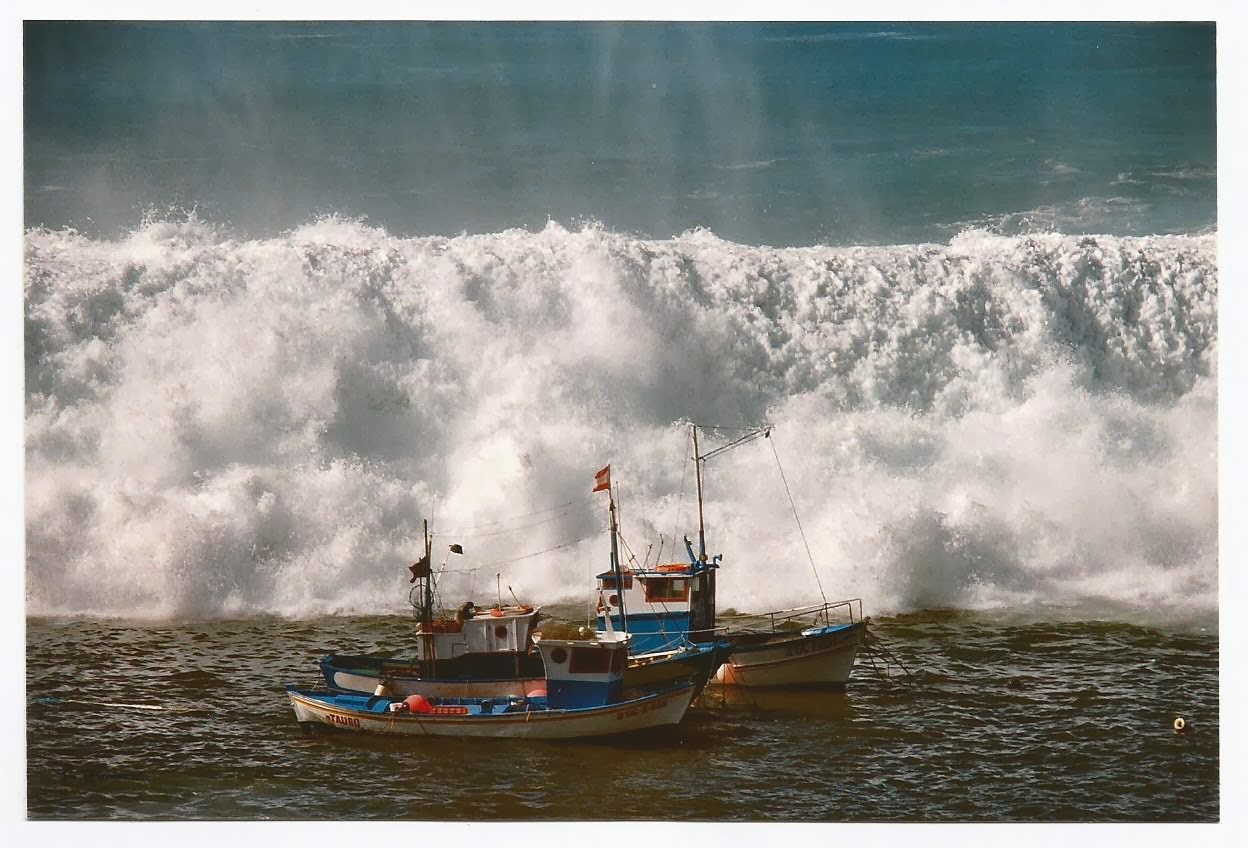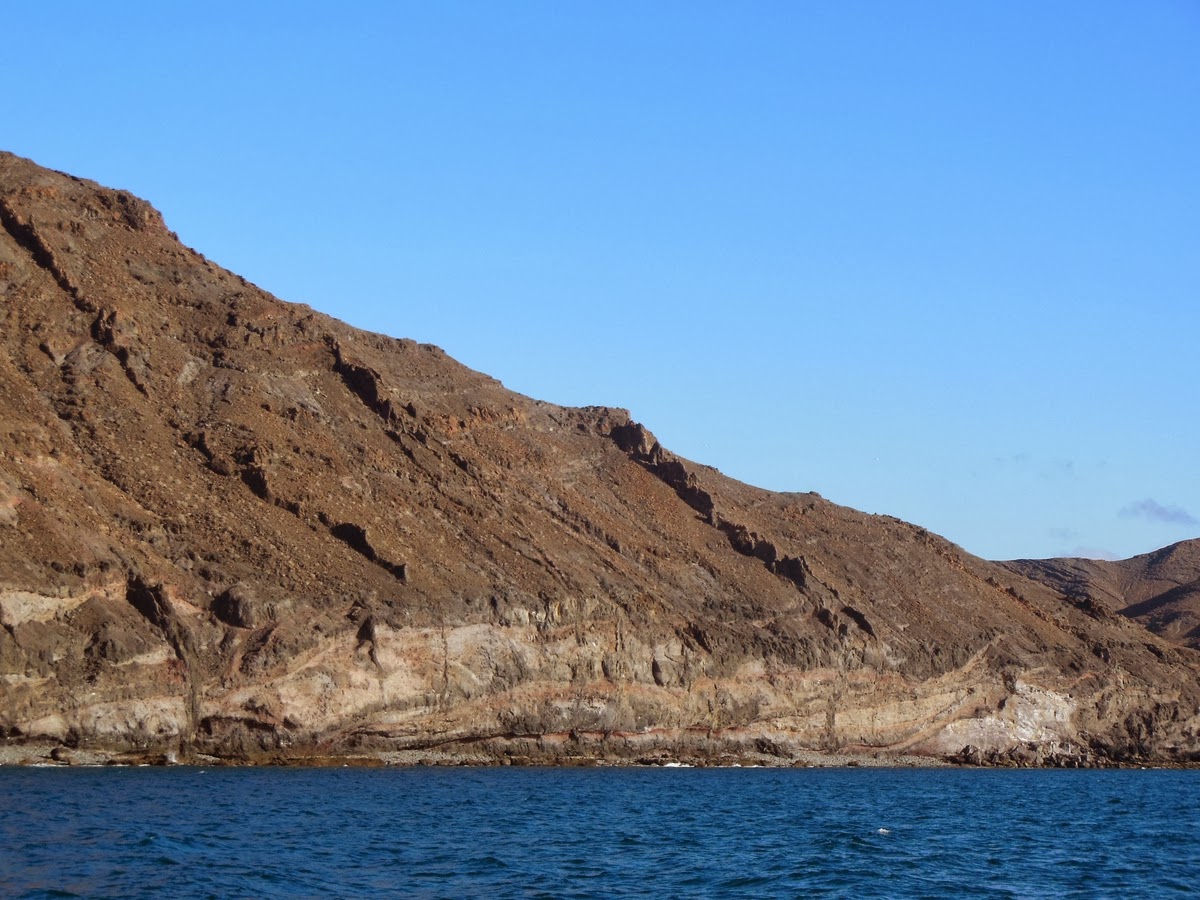We posted our last Blog (Page 4)
once we had finished exploring Fuerteventura and had started to make our way
back north from Morro Jable at the south of the island to Arrecife, the capital
of Lanzarote.
 |
| Progress up to the end of the last Blog (page 4) |
It took us some 24 hours to sail
from the south of Fuerteventura back to Papagayo Bay on the south side of
Lanzarote. As we were against a fresh northeasterly headwind and corresponding
sea we were at first forced to sail “halfway to Morocco” before being able to
tack north to our intended destination.
After two pleasant (free) days at
anchor in Papagayo we found that our anchor chain was trapped under a couple of
rock ledges. While we could, with our tripping line, recover the anchor itself
and indeed much of the chain, we couldn’t recover it all. We therefore got a
local diver to do so. (Every reason for us to more seriously consider carrying
diving gear on board!).
 |
Anchor chain being recovered by divers |
Thereafter we tacked slowly in
light winds and seas the remaining 25 miles to Arrecife where we dressed Island
Drifter overall (i.e. put up all the signal flags) and decorated inside to
kick-start our Christmas festivities.
On arrival we found ourselves
dwarfed by an enormous 33m dark blue catamaran called G-Force. When we investigated we discovered that she
was originally called Orange II and had been skippered by Bruno Peyron. In
2003 he set the 24-hour sailing record of 706 miles! In 2005 he then smashed
the round-the-world record for a crewed yacht when he finished in 50 days and
16 hours. This record stood for five years. As Kingfisher II she was
sailed by Ellen MacArthur on a Round-the-World record attempt which ended when
the yacht’s enormous mast broke in the Southern Ocean. In 2010 she was converted into a fast cruising
yacht with three staterooms for guests by Jack Setton, a famous French yacht
owner and collector. Recently she has
cruised around the world for pleasure in ten months, prior to being sold by
Setton for 2.95 million Euros to a new Turkish owner. The French crew member
(one of six permanently employed) to whom we spoke said she was “very fast but
easy to sail”.
 |
G-Force,
previously Orange II, past-holder of the 24-hour sailing record of 706
miles and of the crewed Round the World Record of 50 days & 16 hrs
|
Alan and Lynn joined us on the evening of 24 December. At one stage we
thought that they might not make it as flights were badly delayed by the storm
that hit the UK before Christmas. Friends in the Solent, where we have our
beach chalet, phoned to advise that OUR property was all right but that half a
tree had come down and severely damaged an adjacent chalet.
 |
Storm damage to adjacent beach chalet at Calshot |
We had a great meal in the sun.
 |
| Mike and Helen enjoying the occasion |
After an appropriate pause for a siesta we promenaded
around the city’s inner lagoon, stopping at one of the “exercise areas” to
build up an appetite for the evening.
The following day we caught a bus
to the surfing village of Caleta de Famara on the northwest corner of the
island and walked 16 kilometres along the coastal path to La Santa via Caleta
Caballo and Club La Santa – each one a surfing mecca.
On finally reaching La Santa we treated ourselves to a
well-earned lunch in one of the small town restaurants.
Next day we had a great downwind sail from Arrecife to
Marina Rubicón – running in advance of a following gale. The
marina is located at the eastern end of the enormous ribbon development of
Playa Blanca on the south of the island.
Marinas, and their costs, are not our “cup of tea” – but Rubicón is a
well-protected location (it needed to be). We also have to accept that the
marina complex is excellent, by any standards.
Marina Rubicón viewed from above with Playa Blanca in the background
While there we discovered that the Canary Island of El
Hierro (200 miles to the west) had had over 500 earth tremors both around and
under the island during the previous few weeks, the strongest measuring 5.2 on the
Richter Scale. Previously, areas at the south of El Hierro had been evacuated and the
rest of the island put on standby, although this does not appear to be happening at present.
Interestingly, it is now being
suggested that the recent heavy swell in the Canary Islands is at least partly
due to seismic activity around El Hierro.
Since, in the gale, we were
clearly going nowhere that day by sea, we hired a car in Rubicón to give
us greater flexibility to look around with Alan and Lynn and to visit some of
the places not accessible by bus. These included:
· Timanfaya National Park Fire Mountains (which we had already
been to – but it was well worth revisiting) and their Restaurant El Diablo
where we again enjoyed a half chicken grilled on the volcanic BBQ.
· The island’s central massif, which we’d not been to,
and which contains a staggeringly large area of vineyards – each plant
surrounded by a horseshoe wall (zocco) designed to trap condensation at night
and to protect against the prevailing wind.
 |
| Vines growing in protective zoccos |
· The Estrecho del Rió between
Lanzarote and Graciosa, where the anchorage was empty – not surprising, given
the gale in progress.
· Orzola, the north-facing ferry port that services Graciosa,
was being battered by the northeast gale. It was clearly giving the ferry
skippers a challenge – judging by the “throat cutting” action given by the
incoming captain!
Our passage south allowed us to view the
impressive sandy coastline of the Jandía peninsula including the Isthmo de Pared. The isthmus
is comprised of sand blown from the Sahara over several millennia and joins the
“mainland” of Fuerteventura to what used to be the island of Jandía.
5lb tuna caught off
Fuerteventura
On the way we took a closer look at some of the minor
anchorages in the four coves along the rocky coast west of Rosario that we had
only superficially looked at on our previous sail south. We were particularly
impressed by those at Las Playitas, Ginijinamar and Taralelejo, which appeared
to be perfectly adequate for an overnight stop in prevailing northerly winds.
We arrived at Morro Jable at low
tide and had to hoist Helen up onto the reception and fuel dock wall in order for her
to take the lines and organise a berth. We ended up “parked” on a pontoon in
the inner harbour opposite Fisher & Paykel, an impressive 84ft ketch
which came second to Peter Blake in a sister boat in the 1989 Whitbread Round
the World Race. It is now used as a
sail training boat for racing enthusiasts.
Chart plotter showing Island
Drifter “halfway to Morocco” before tacking north
We came back to
Arrecife in order to see the celebrations of “The Night of the Kings” on 5
January (which was followed by a public holiday on 6 January to allow everyone
to recover). In brief, the Three Kings on their camels (the equivalent of Santa
on his sleigh) bring symbolic Christmas presents on the evening of 5
January. People subsequently hand out
their presents on the morning of 6 January. (Christmas Day is more simply
celebrated with family get-togethers.)
 |
| Arrecife population and ourselves enjoying Tapas evening |
 | ||
| The sandy streets of Caleta del
Sebo
We stopped for lunch at an excellent fish restaurant,
Restaurant Girasol, where we shared a very large Pargo (a Pink Dentix) and four
raciones (half portions again, when a full portion would have floored lesser
men).
|
 |
| Alan and Lynn relaxing on the
sail back to Arrecife
Back in Marina Lanzarote, Arrecife, we enjoyed a bowl of
homemade guacamole and glasses of Bucks Fizz, which seem to have become part of
our staple diet over Christmas! The
outstandingly good, large Canarian avocados at 40 cents each and very drinkable
Cava at 1.90 Euros hardly broke the bank.
Our second course of Peppers Padron has also become a boat favourite.
Lynn’s excellent salad wraps and dessert of caramelised Canary oranges
completed our final meal together on board.
|
 |
| Peppers Padron
We needed an early night as Alan and Lynn had to
catch a taxi to the airport at 5.45 a.m. and none of us had slept well at
Graciosa thanks to the noise and vibrations from the trapped anchor chain.
We are now having a bit of a sort-out in Arrecife before
heading back south to Fuerteventura where we are being joined for a week by Ian
and Ginny Ross who, like Alan and Lynn, sailed with us in Norway last year.
|
WE’D
LIKE TO TAKE THIS OPPORTUNITY
TO
WISH YOU ALL
A
VERY HAPPY AND PROSPEROUS NEW YEAR!







































All this good eating just makes the pair of you look ever younger! Perhaps you have discovered the secret which escapes the rest of us storm bound mortals.......
ReplyDeleteHave a great New Year with many pleasures still to come.
bob & Beryl
Did our postcard from Cape Town arrive at Marina Lanzarote?
ReplyDeleteJames & Carol Bryant